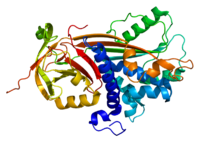
Photo from wikipedia
Age-related macular degeneration (AMD) is the eye disease with the highest epidemic incidence, and has great impact on the aged population. Wet-type AMD commonly has the feature of neovascularization, which… Click to show full abstract
Age-related macular degeneration (AMD) is the eye disease with the highest epidemic incidence, and has great impact on the aged population. Wet-type AMD commonly has the feature of neovascularization, which destroys the normal retinal structure and visual function. So far, effective therapy options for rescuing visual function in advanced AMD patients are highly limited, especially in wet-type AMD, in which the retinal pigmented epithelium and Bruch’s membrane structure (RPE-BM) are destroyed by abnormal angiogenesis. Anti-VEGF treatment is an effective remedy for the latter type of AMD; however, it is not a curative therapy. Therefore, reconstruction of the complex structure of RPE-BM and controlled release of angiogenesis inhibitors are strongly required for sustained therapy. The major purpose of this study was to develop a dual function biomimetic material, which could mimic the RPE-BM structure and ensure slow release of angiogenesis inhibitor as a novel therapeutic strategy for wet AMD. We herein utilized plasma-modified polydimethylsiloxane (PDMS) sheet to create a biomimetic scaffold mimicking subretinal BM. This dual-surface biomimetic scaffold was coated with laminin and dexamethasone-loaded liposomes. The top surface of PDMS was covalently grafted with laminin and used for cultivation of the retinal pigment epithelial cells differentiated from human induced pluripotent stem cells (hiPSC-RPE). To reach the objective of inhibiting angiogenesis required for treatment of wet AMD, the bottom surface of modified PDMS membrane was further loaded with dexamethasone-containing liposomes via biotin-streptavidin linkage. We demonstrated that hiPSC-RPE cells could proliferate, express normal RPE-specific genes and maintain their phenotype on laminin-coated PDMS membrane, including phagocytosis ability, and secretion of anti-angiogenesis factor PEDF. By using in vitro HUVEC angiogenesis assay, we showed that application of our membrane could suppress oxidative stress-induced angiogenesis, which was manifested in decreased secretion of VEGF by RPE cells and suppression of vascularization. In conclusion, we propose modified biomimetic material for dual delivery of RPE cells and liposome-enveloped dexamethasone, which can be potentially applied for AMD therapy.
Journal Title: International Journal of Molecular Sciences
Year Published: 2019
Link to full text (if available)
Share on Social Media: Sign Up to like & get
recommendations!